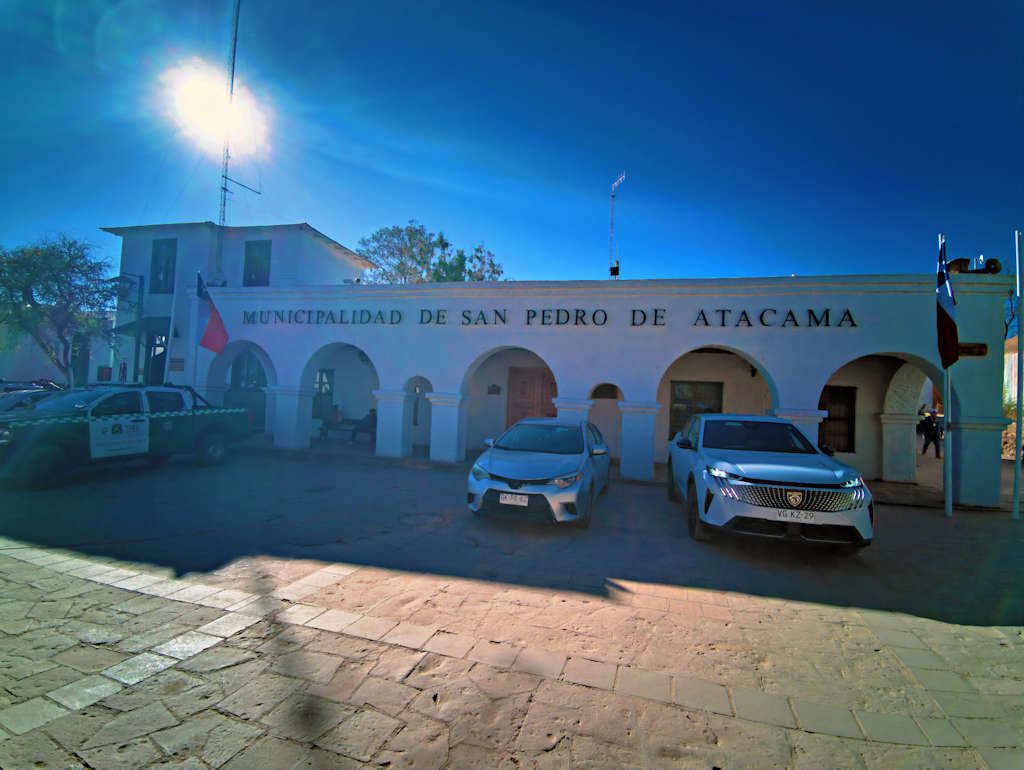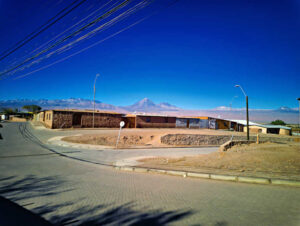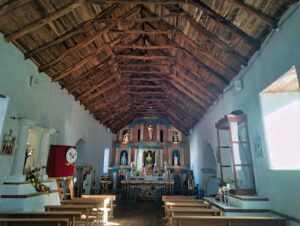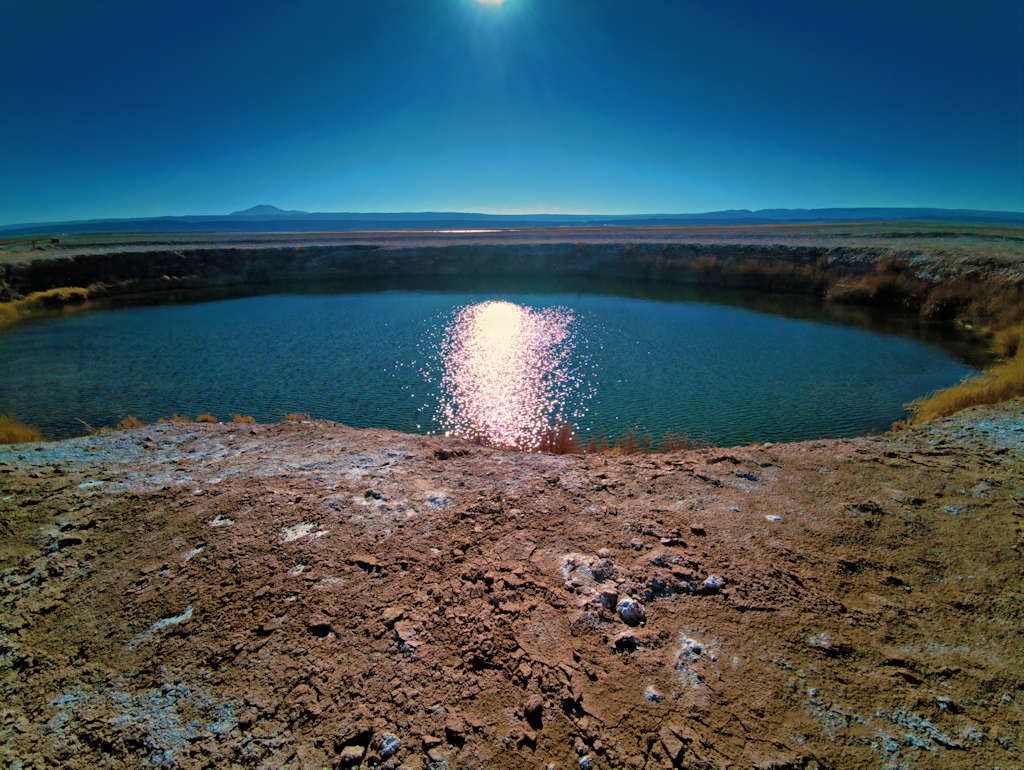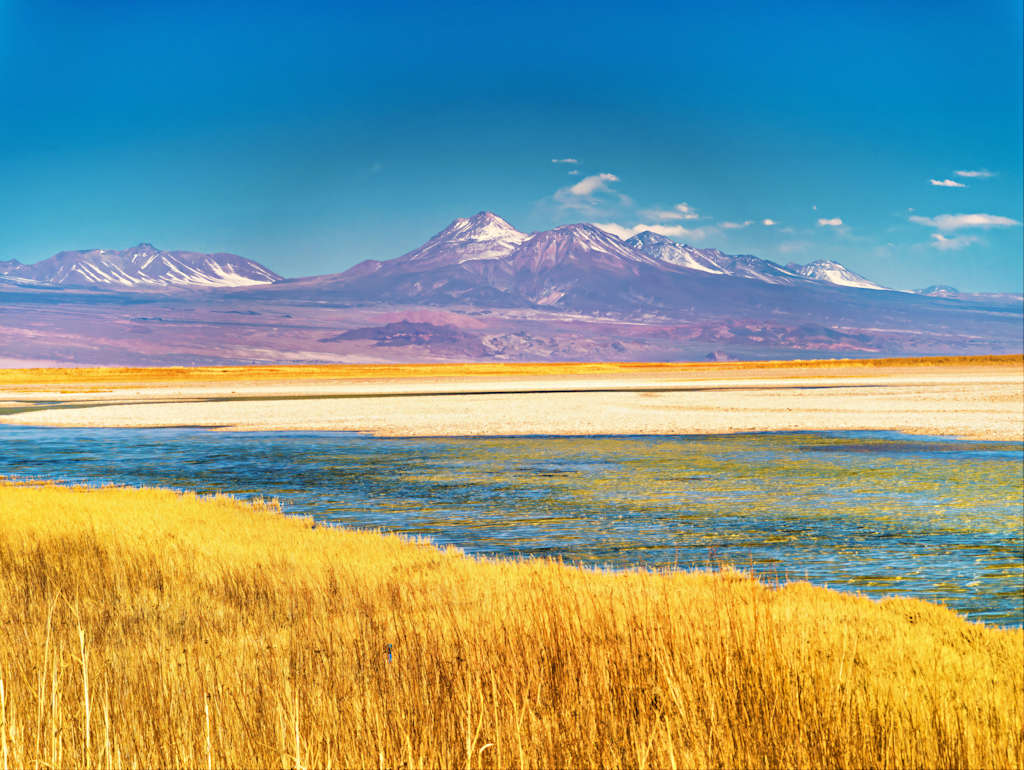San Pedro de Atacama: Oasis Town, Gateway to the Desert, Chile - interactive 360-degree video
If you are viewing this on a mobile device, please turn to LANDSCAPE position. Drag the view on the screen with your finger (or move the device around) and you will see everything all around you – even what’s behind or on the ground. Viewing on a PC? Use the mouse to drag the view anywhere you want to see. If you have a VR viewer (goggles) you will be fully immersed. Better than IMAX! SUGGESTION: see the video again, change the viewing angles. You will discover new things!
IMPORTANT! Please click on the "Watch on YouTube" link for best viewing. The embedded small screen is inadequate for interactive 360 degree videos.
To see the same video in conventional screen format (non 360-degree video)
click here
360 preference survey
- If you’d like to research or purchase a 360-degree camera, here’s a link to a 360-degree camera like the one I used to produce my videos. I have nothing but good things to say about my camera (which I purchased from the same website as the link above).
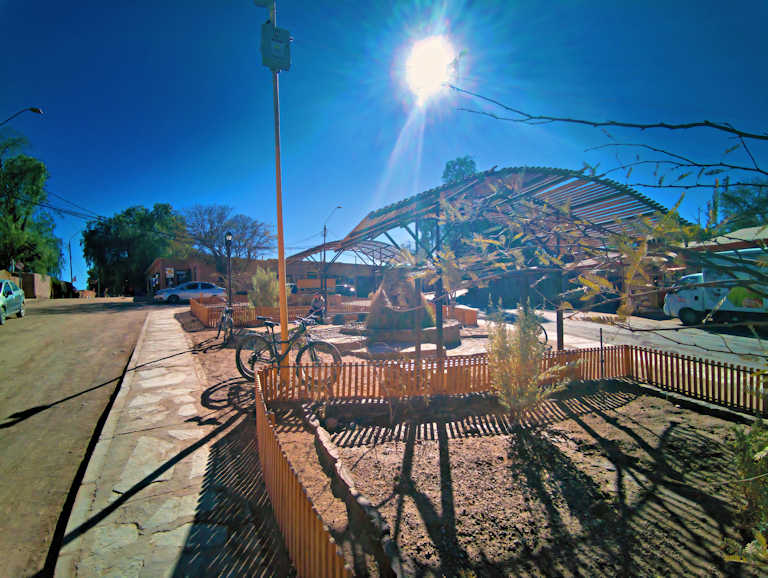
Introduction to San Pedro de Atacama
- San Pedro de Atacama is your gateway to the Atacama Desert. It is an Oasis, located in the heart of the driest desert on Earth. Its mere existence is a miracle. The water that sustains the community and the surrounding vegetation originates from the runoff of the Andes Mountains in the form of three “rivers”: the San Pedro River, the Vilama River and the Puritama River. I put the quotation marks around “rivers” because these rivers are nothing like you might imagine. True, they have a clearly defined river basin, but it is mostly a dry river bed. If you look carefully, you see in the middle a very thin trickle of water, which sometimes is there, other times is absent.
- The town has a system of canals that diverts the little water there is into different directions, for different uses. Besides the needs of the approximately 2,500 town permanent residents, there are the 10,000 (or so) daily tourists. As incredible as it seems, there is well established (for centuries, perhaps millennia) agriculture, using terrace systems and some livestock (domesticated llamas and alpacas). There even are a couple of small parks in town and you can see quite a few large trees. These trees are super-adapted to the arid environment, grow extremely slowly and require very little water. Here are the kind of trees you will see in San Pedro:
- Algarrobo (Chilean/White Algarrobo): These trees can grow quite tall, with one variety reportedly reaching up to 15 meters in height. They are considered a gift from the gods by local indigenous peoples.
- Chañar trees: These are another significant, resilient tree found in the area that can grow up to 10 meters high.
- Carob trees (Algarrobo): These provide shade in the central plaza.

History of San Pedro de Atacama
- The history of San Pedro de Atacama is deeply rooted in pre-Columbian times. The first inhabitants date back perhaps 11,000 years. The community served as an important center for the Atacameño people (also known as the Lickanantay) who adapted remarkably well to the arid conditions, and employed farming techniques that allowed them to cultivate crops in the desert. They also developed sophisticated crafts like basketry and pottery.
- Some sources suggest that the town was founded around 1450 by the Inca Yupanqui. The name San Pedro de Atacama was given by the Spanish conquistador Pedro de Valdivia when he camped there in 1540 during his journey to conquer Chile, naming it partly in his own honor. During the Spanish colonization in the 16th century, San Pedro de Atacama emerged as an important strategic location due to its proximity to the highland trade routes. Events such as the establishment of the Church of San Pedro in 1789 symbolize the blend of indigenous and colonial influences that characterize the area.
- Before San Pedro de Atacama became a tourist destination, it was an important point on the trade route between Peru and Bolivia. It has historically been a strong source of mineral wealth, particularly nitrate in the 19th century and copper in the 20th century, forming a significant part of the Chilean economy. San Pedro de Atacama is often considered the archaeological capital of Chile due to the extensive traces of ancient civilizations, including pukarás (fortress walls), that surround the area.
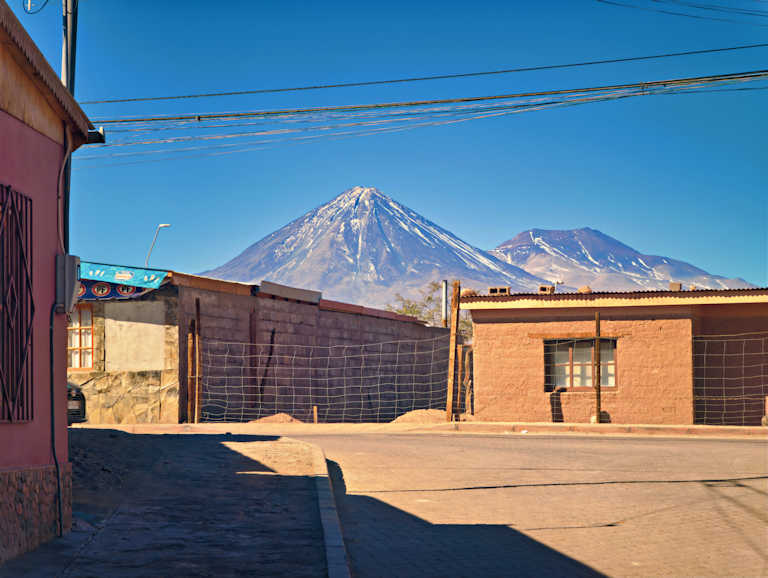
San Pedro de Atacama as an Architectural Oasis
- Another spectacular aspect of this town is its architecture. Except for the Municipal Building, that looks “new” and “modern”, every building in the entire town preserves a traditional architectural look that seems to be centuries-old. Walking the streets of San Pedro transposes you to another time. It almost feels like you are walking on a movie set, except that here everything is real: these are real houses, real inns and guest houses and real commercial establishments. There must be “new” buildings among all the buildings of San Pedro, but they are impossible to spot as everything is built in the same traditional architectural style. I don’t think anyone visiting San Pedro comes here expecting an architectural treat, but this town is, indeed, an architectural gem that is still under the radar. Come to see it before all of this is spoilt by the all mighty greed and franchise hotels popping all over the place.
- One other aspect not often mentioned is the sheer majesty of the location and surrounding views. As soon as I walked out of my guest house and turned a corner, I was awe-struck by seeing the perfect cone of the Licancabur Volcano that presides in the distance over the town. The snow-powdered mountains are visible in the distance from everywhere in town. It is an imposing view that does not get old!
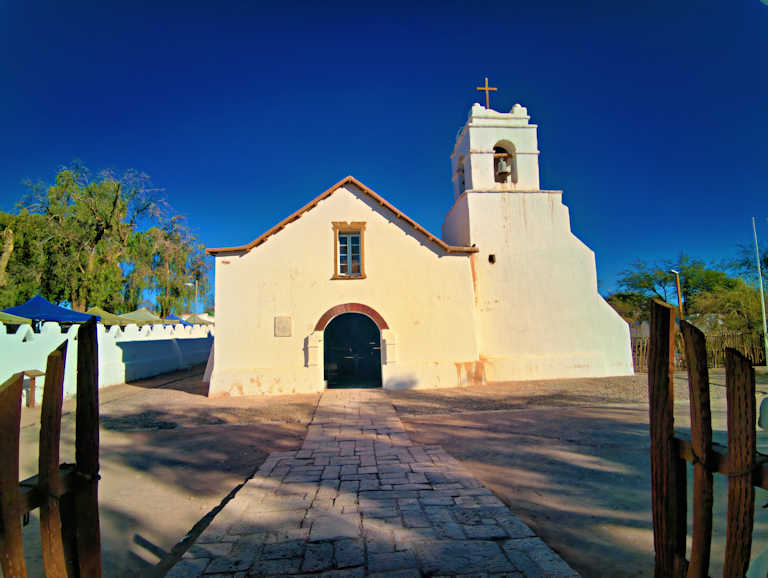
Iglesia de San Pedro de Atacama
- The Town Church (Iglesia de San Pedro de Atacama) is a prominent landmark in the town center, constructed primarily of whitewashed adobe with a distinct colonial architectural style. Records indicate that a mission chapel existed as early as 1557. Constructed in 1641, and rebuilt in 1745 the Church is noted for its simple and sober design.
- The ceiling is particularly unique, made from wood sourced from the algarroba tree and cardón cactus. The bell tower was added later; initial documents from 1782 mention four bells, but a drawing from 1860 shows the church without a tower, suggesting the first tower was wooden and built in the late nineteenth century, eventually being reconstructed with stone and adobe in 1964. The church is now designated as a national monument.
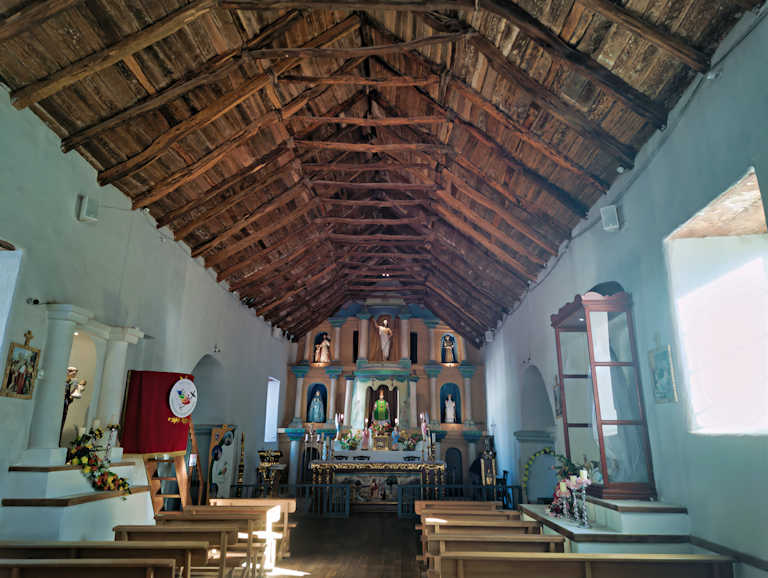
San Pedro de Atacama as a Tourist Hub
- Today, San Pedro de Atacama serves as a gateway to the Atacama Desert, attracting tourists from around the globe who embark on tours to explore its stunning natural wonders and rich cultural heritage. The town’s hospitality and charm invite visitors to experience the myriad attractions, such as the Valley of the Moon and the El Tatio geysers, making it one of the most sought-after destinations in Chile.
- The journey from Santiago to San Pedro de Atacama involves reaching Calama (CJC), the nearest airport, followed by a final segment to the oasis.
- The straight-line distance between Santiago and San Pedro de Atacama is approximately 1340 km. The road distance is slightly longer, estimated at around 1623.3 km. Here are the transportatin options from Santiago de Chile:
- By Car: Driving from Santiago typically takes about 17 to 18 hours of pure driving time, often requiring an overnight stop, such as in Copiapo, to complete the journey.
- By Bus (Direct/Via Calama): The bus journey is considerably long, taking approximately 23 to 24 hours]. Comfortable options like salon-cama (lounge bed) are available for the extended trip.
- By Air/Plane: This is the fastest method. The flight from Santiago International Airport (SCL) to El Loa Airport (CJC) in Calama takes about 2 hours [6.2]. Upon arrival in Calama, a further transfer (bus or private transfer) of about 1.5 hours is required to reach San Pedro de Atacama, bringing the total travel time via air and ground transfer to around 4 hours.
- There are a substantial number of daily flights. The number of daily flights varies, but there are at least a dozen options. The price of airfare from Santiago, of course, is extremely variable, as airline algorithms play all kinds of tricks to try and extract the most possible amount of money from everyone. Book early and be aware of all kind of “extras” that may/will be added to the base fare.

Tourist Services
- Everything is easily available in San Pedro. There are approximately 13 hotels, several inns, and various guest houses/hostels. The range of quality is extensive, from high-end luxury lodges to more modest lodgings. There are many car rental and bicycle rental places on the main streets of San Pedro, as well as a multitude of travel agencies and bureaus, which all offer similar trips to all the attractions in the area. If you did not make all your bookings in advance, it sill be easy in San Pedro to “play it by ear”.
- As far as eating, there are plenty of restaurants on the main tourist streets. They seem to all offer what the average “tourist” would want to eat, and they are all, in my opinion, seriously overpriced.
- If you want to eat local authentic food, like the local population, walk outside the “tourist box” of the downtown areas. There are many local restaurants that cater to the local population, that have excellent food (cooked by “mama” on a stove behind the counter). These local restaurants usually have a blackboard with today’s menu right by the door. The menu is in Spanish and interactions with the staff need to be in Spanish, but the food is fantastic and the prices are more than reasonable. That is the real food of the Atacameños and of the local population!
- In conclusion, my personal experience in San Pedro de Atacama, throughout my entire stay, as well as all the epic trips I took, was entirely positive. I highly recommend San Pedro and the marvels of the Atacama Desert!


Download full-size master image files
Please use our images!
Your purchase is important to us!
- The financial reward is important. The moral boost we receive when someone cares enough to click that “ADD TO CART” button: priceless! Thanks!
- You may use the downloaded images as wallpaper, in a slide show, or to supplement your collection of images from a location you care about. Other possible use cases: a research paper, newsletter or personal website.
- The size of our master photo files is no less than 7952 x 5304,.JPEG, with very light compression. The photos taken during a 360 degree shoot (featured on a blog page that includes a 360 degree video) are taken in RAW format, with a phone camera. The RAW file is “developed” and processed with advanced software, including increasing the resolution with AI and AI upscaling. The resulting large format file is then polished for its final creative look.
Conditions of use for downloaded images:
- Downloading an image at listed price does not provide ownership of the image (we retain copyright). It provides a license for limited use and distribution of the downloaded image.
- Distribution is limited to 50,000 exposures or copies and for projects with a total budget of $5,000 or less. No billboards or magazine covers.
- May be used only with attribution as follows:
-
- © Photography by Cristian Coban, visit
whatsitliketovisit.com
- Any image or video purchased or copied from our website may NOT be used for resale, download or redownload, distribution or redistribution, or any other further commercial use.
- We accommodate larger projects and distribution at industry competitive rates. Please Contact us with details of your project and we will be happy provide a quote.

